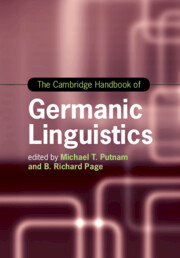Book contents
- The Cambridge Handbook of Germanic Linguistics
- Cambridge Handbooks in Language and Linguistics
- The Cambridge Handbook of Germanic Linguistics
- Copyright page
- Contents
- Figures
- Maps
- Tables
- Contributors
- Acknowledgments
- Germanic Languages
- Part I Phonology
- Part II Morphology and Agreement Systems
- Part III Syntax
- Part IV Semantics and Pragmatics
- Chapter 24 Modality in Germanic
- Chapter 25 Tense and Aspect in Germanic Languages
- Chapter 26 Prepositions and Particles
- Chapter 27 Negative and Positive Polarity Items
- Chapter 28 Grammatical Reflexes of Information Structure in Germanic Languages
- Part V Language Contact and Nonstandard Varieties
- Index
- References
Chapter 24 - Modality in Germanic
from Part IV - Semantics and Pragmatics
Published online by Cambridge University Press: 31 March 2020
- The Cambridge Handbook of Germanic Linguistics
- Cambridge Handbooks in Language and Linguistics
- The Cambridge Handbook of Germanic Linguistics
- Copyright page
- Contents
- Figures
- Maps
- Tables
- Contributors
- Acknowledgments
- Germanic Languages
- Part I Phonology
- Part II Morphology and Agreement Systems
- Part III Syntax
- Part IV Semantics and Pragmatics
- Chapter 24 Modality in Germanic
- Chapter 25 Tense and Aspect in Germanic Languages
- Chapter 26 Prepositions and Particles
- Chapter 27 Negative and Positive Polarity Items
- Chapter 28 Grammatical Reflexes of Information Structure in Germanic Languages
- Part V Language Contact and Nonstandard Varieties
- Index
- References
Summary
Modality is a category encompassing many different aspects of language use, and the literature concerned with this topic extends from antiquity to the modern age. This chapter provides an introduction to the notion of modality, discusses how it relates to other major categories such as tense, aspect and mood, and illustrates how modalities are instantiated morphosyntactically in the Germanic languages. We are specifically addressing cross-linguistic differences and similarities; for instance, only a few of the Germanic languages employ subjunctive moods productively, whereas all use modal auxiliaries. The discussion revolves around types of modality and their typical exponents with a particular emphasis on the deontic (root, event) v. epistemic (evidential, propositional) modalities and potential commonalities between them. Other central topics addressed are the notions of authority and controllability. Finally, we investigate some recent trends in the literature on speech act modality in the Germanic languages, including the potential role of complementizers.
Keywords
- Type
- Chapter
- Information
- The Cambridge Handbook of Germanic Linguistics , pp. 567 - 590Publisher: Cambridge University PressPrint publication year: 2020

